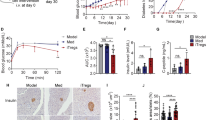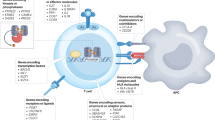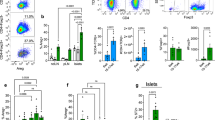Abstract
In nonobese diabetic (NOD) mice, β–cell reactive T–helper type 1 (Th1) responses develop spontaneously and gradually spread, creating a cascade of responses that ultimately destroys the β–cells. The diversity of the autoreactive T–cell repertoire creates a major obstacle to the development of therapeutics. We show that even in the presence of established Th1 responses, it is possible to induce autoantigen–specific anti–inflammatory Th2 responses. Immune deviation of T–cell responses to the β–cell autoantigen glutamate decarboxylase (GAD65), induced an active form of self–tolerance that was associated with an inhibition of disease progression in prediabetic mice and prolonged survival of syngeneic islet grafts in diabetic NOD mice. Thus, modulation of autoantigen–specific Th1/Th2 balances may provide a minimally invasive means of downregulating established pathogenic autoimmune responses.
This is a preview of subscription content, access via your institution
Access options
Subscribe to this journal
Receive 12 print issues and online access
$209.00 per year
only $17.42 per issue
Buy this article
- Purchase on Springer Link
- Instant access to full article PDF
Prices may be subject to local taxes which are calculated during checkout
Similar content being viewed by others
References
Castano, L. & Eisenbarth, G.S., I-diabetes: A chronic autoimmune disease of human, mouse and rat. Annu. Rev. Immunol. 8, 647–679 (1990).
Rossini, A.A., Greiner, D.L., Friedman, H.P. & Mordes, J.P. Immunopathogenesis of diabetes mellitus. Diabetes Rev. 1, 43–75 (1993).
Bach, J.F. Insulin-dependent diabetes mellitus as an autoimmune disease. Endocr. Rev. 15, 516–542 (1994).
Kaufman, D.L. et al. Spontaneous loss of T-cell tolerance to glutamic acid decar-boxylase in murine insulin-dependent diabetes. Nature 366, 69–72 (1993).
Tisch, R. et al. Immune response to glutamic acid decarboxylase correlates with insulitis in non-obese diabetic mice. Nature 366, 72–75 (1993).
Baekkeskov, S. et al. Identification of the 64K autoantigen in insulin-dependent diabetes as the GABA-synthesizing enzyme glutamic acid decarboxylase. Nature 347, 151–156 (1990).
Palmer, J.P. Predicting IDDM: Use of humoral immune markers. Diabetes Rev. 1, 104–115 (1993).
Zamvil, S.S. & Steinman, L. The T lymphocyte in experimental allergic encephalomyelitis. Annu. Rev. Immunol. 8, 579–621 (1990).
Fairchild, P.J., Thorpe, C.J., Travers, P.J. & Wraith, D.C. Modulation of the immune response with T-Cell epitopes: The ultimate goal for specific im-munotherapy of autoimmune disease. Immunology 81, 487–496 (1994).
Mosmann, T.R. & Coffman, R.L. TH1 and TH2 cells: Different patterns of lymphokine secretion lead to different functional properties. Annu. Rev. Immunol. 7, 145–173 (1989).
Tisch, R. & Mc Devitt, H.O. . Antigen-specific immunotherapy: Is it a real possibility to combat T-cell-mediated autoimmunity?. Proc. Natl. Acad. Sci. USA 91, 437–438 (1994).
Rabinovitch, A. Immunoregulatory and cytokine imbalances in the pathogenesis of IDDM. Therapeutic intervention by immunostimulation? Diabetes 43, 613–621 (1994).
Liblau, R.S., Singer, S.M. & McDevitt, H.O. Th1 and Th2 CD4+ T cell>s in the pathogenesis of organ-specific autoimmune diseases. Immunol. Today 16, 34–38 (1995).
Lacy, P.E. Status of islet cell transplantation. Diabetes Rev. 1, 76–92 (1993).
Sutherland, D.E.R. Pancreatic transplantation. Diabetes Rev. 1, 152–165 (1993).
Forsthuber, T., Yip, H.C. & Lehmann, P.V. Induction of Th1 and Th2 immunity in neonatal mice. Science 271, 1728–1730 (1996).
Rapoport, M.J. et al. Interleukin 4 reverses T-cell proliferative unresponsiveness and prevents the onset of diabetes in nonobese diabetic mice. J. Exp. Med. 178, 87–99 (1993).
Elias, D. & Cohen, I.R. Peptide therapy for diabetes in NOD mice. Lancet 343, 704–706 (1994).
Elliott, J.F. et al. Immunization with the larger isoform of mouse glutamic acid decarboxylase (GAD67) prevents autoimmune diabetes in NOD mice. Diabetes 43, 1494–1499 (1994).
Pleau, J.M., Fernandez-Saravia, F., Esling, A., Homo-Delarche, F. & Dardenne, M. Prevention of autoimmune diabetes in nonobese diabetic female mice by treatment with recombinant glutamic acid decarboxylase (GAD65). Clin. Immunol. Immunopathol. 76, 90–95 (1995).
Muir, A. et al. Insulin immunization of nonobese diabetic mice induces a protective insulitis characterized by diminished intraislet interferon-g transcription. J. Clin. Invest. 95, 628–634 (1995).
Daniel, D. & Wegmann, D.R. Protection of nonobese diabetic mice from diabetes by intranasal or subcutaneous administration of insulin peptide B-(9–23). Proc. Nat. Acad. Sci. USA 93, 956–960 (1996).
Harrison, L.C. et al. Inverse relation between humoral and cellular immunity to glutamic acid decarboxylase in subjects at risk of insulin-dependent diabetes. Lancet 341, 1365–1369 (1993).
Thai, A.-C. & Eisenbarth, G. S. Natural history of IDDM. Diabetes Rev. 1, 1–14 (1993).
Tian, J. et al. Nasal administration of glutamate decarboxylase (GAD65) peptides induces Th2 responses and prevents murine insulin-dependent diabetes. J. Exp. Med. 183, 1561–1567 (1996).
Lee, D.S., Tian, J., Phan, T. & Kaufman, D.L. Cloning and sequence analysis of a murine cDNA encoding glutamate decarboxylase (GAD65). Biochem. Biophys. Acta 1216, 157–160 (1993).
Wicker, L.S., Miller, B.J. & Mullen, Y. Transfer of autoimmune diabetes mellitus with splenocytes from nonobese diabetic (NOD) mice. Diabetes 35, 855–860 (1986).
Ramsdell, F. & Fowlkes, B.J. Maintenance of in vivo tolerance by persistence of antigen. Science 257, 1130–1134 (1992).
Qin, H.Y., Sadelain, M.W., Hitchon, C., Lauzon, J. & Singh, B., Freund's adjuvant-induced T cells prevent the development and adoptive transfer of diabetes in nonobese diabetic mice. J. Immunol. 150, 2072–2080 (1993).
Author information
Authors and Affiliations
Rights and permissions
About this article
Cite this article
Tian, J., Clere-Salzler, M., Herschenfeld, A. et al. Modulating autoimmune responses to GAD inhibits disease progression and prolongs islet graft survival in diabetes–prone mice. Nat Med 2, 1348–1353 (1996). https://doi.org/10.1038/nm1296-1348
Received:
Accepted:
Issue Date:
DOI: https://doi.org/10.1038/nm1296-1348
This article is cited by
-
Increased risk for T cell autoreactivity to ß-cell antigens in the mice expressing the Avy obesity-associated gene
Scientific Reports (2019)
-
Regulatory T cell dysfunction in type 1 diabetes: what’s broken and how can we fix it?
Diabetologia (2017)
-
GAD vaccine reduces insulin loss in recently diagnosed type 1 diabetes: findings from a Bayesian meta-analysis
Diabetologia (2017)
-
Thinking bedside at the bench: the NOD mouse model of T1DM
Nature Reviews Endocrinology (2015)
-
PD-1-dependent restoration of self-tolerance in the NOD mouse model of diabetes after transient anti-TCRβ mAb therapy
Diabetologia (2015)



